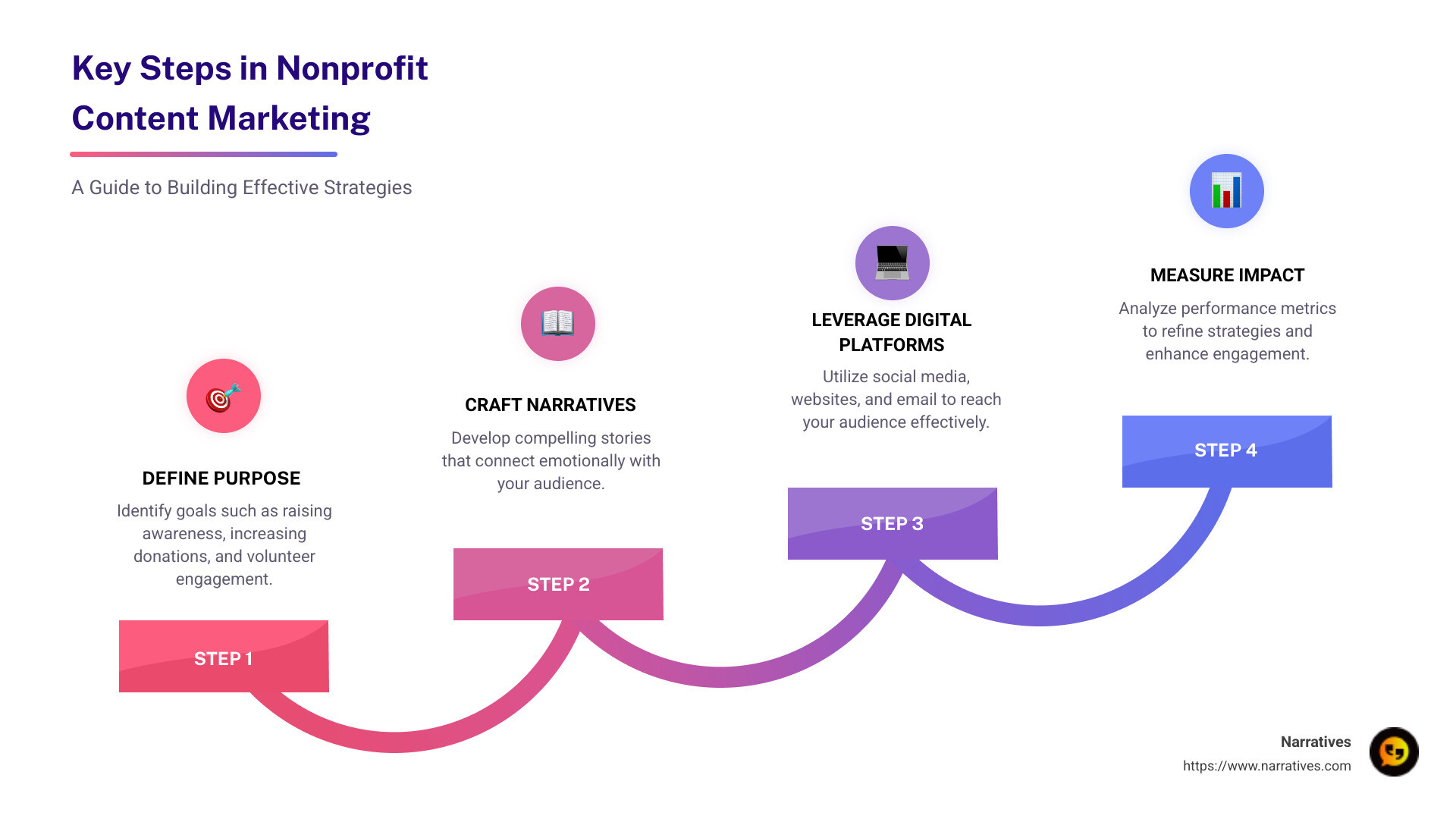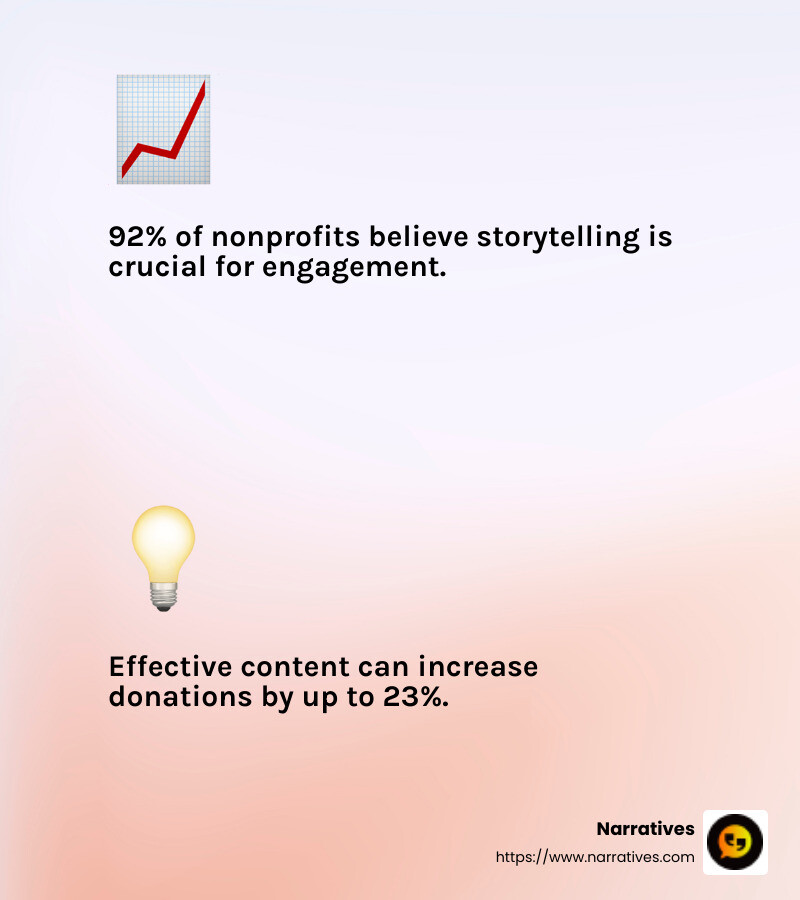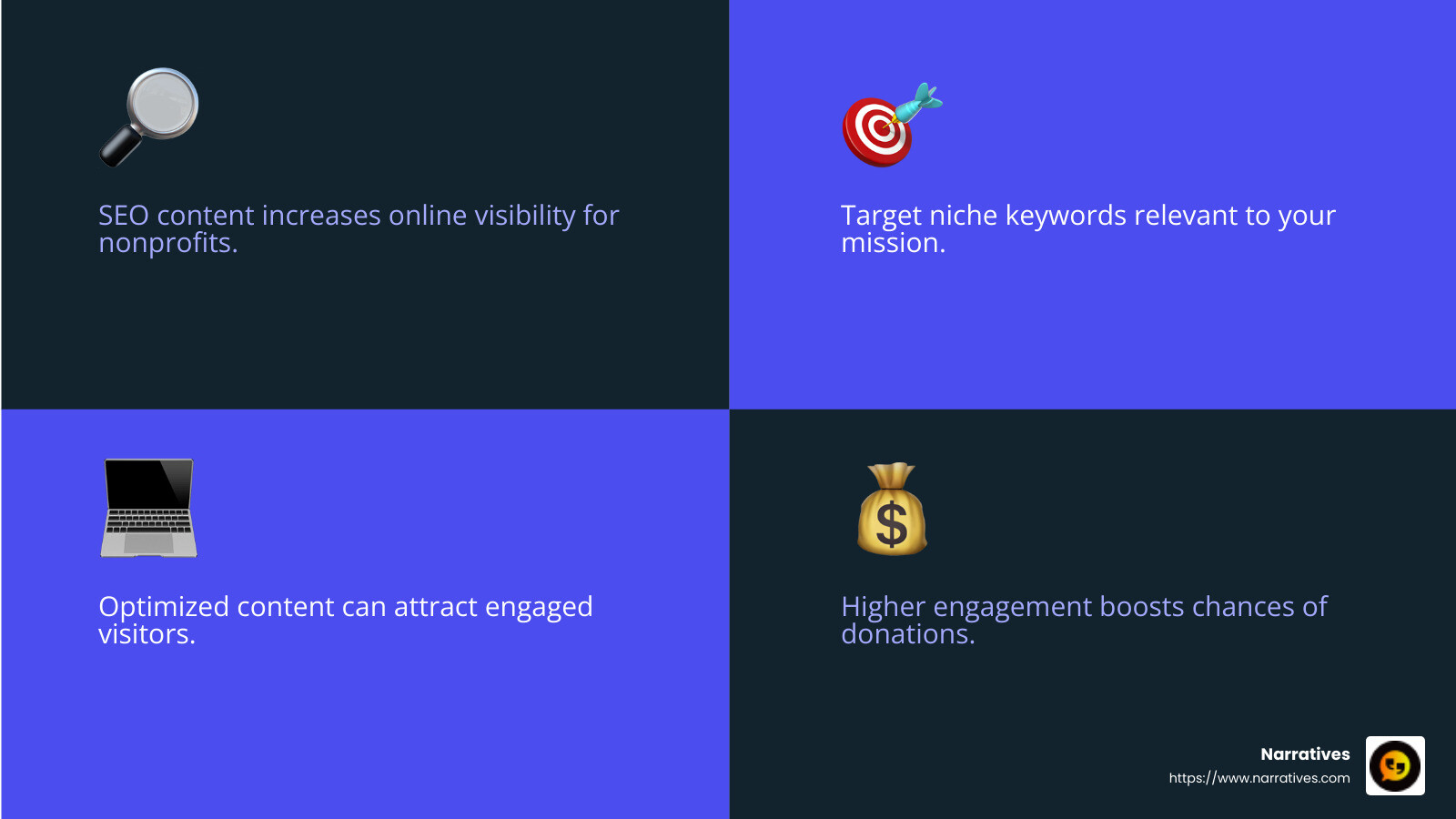Strategic Storytelling: Building a Nonprofit Content Plan

nonprofit content marketing is not just a buzzword—it's a transformative approach that connects mission-driven organizations with their audience in meaningful ways. At its core, it combines storytelling and digital marketing to create captivating content that sparks action. Here's a quick overview to understand its significance:
- Purpose: Raise awareness, increase donations, and drive volunteer engagement.
- Strategies: Use compelling narratives and digital platforms to reach the right audience.
- Impact: Share the stories of those you serve to inspire change and build community support.
Today, the digital world offers nonprofits endless opportunities for outreach. By leveraging storytelling within digital marketing frameworks, organizations can amplify their missions like never before. Yet, many struggle to craft stories that truly resonate. The key lies in understanding both the tools and the narrative power at your disposal.
In the sections that follow, we’ll dig into understanding nonprofit content marketing, uncover key strategy elements, explore top content formats, and guide you in building a robust marketing plan. With the right approach, storytelling becomes not just a method of sharing your mission, but a powerful driver of community action and support.

Understanding Nonprofit Content Marketing
Nonprofit content marketing is a crucial tool for mission-driven organizations. It involves creating and sharing materials like blogs, videos, and social media posts to educate, engage, and inspire your audience. But what exactly does it mean, and why is it so important?
Definition
Nonprofit content marketing is all about using storytelling to promote your mission and values. It's not just about pushing out information. It's about crafting narratives that connect emotionally with your audience. This approach helps nonprofits share their stories in a way that encourages people to support their cause.
Purpose
The main goal of nonprofit content marketing is to raise awareness, drive donations, and increase volunteer involvement. By sharing impactful stories and valuable information, nonprofits can build strong relationships with their supporters. This connection is vital for long-term success and sustainability.
Engagement
Engaging your audience is at the heart of any successful content marketing strategy. For nonprofits, this means creating content that resonates with people's values and emotions. It involves understanding what your audience cares about and delivering content that speaks to those interests. Engaged supporters are more likely to donate, volunteer, and advocate for your cause.
Mission-Driven
Every piece of content should align with your organization's mission and goals. This mission-driven approach ensures that your messaging is consistent and focused. It's about highlighting the impact of your work and showing how your audience can make a difference. By keeping your mission at the forefront, you can create content that not only informs but also inspires action.

In the next sections, we'll explore the key elements of a nonprofit content strategy, top content formats, and how to build a comprehensive marketing plan. With these insights, you can harness the power of storytelling to propel your nonprofit's mission forward.
Key Elements of a Nonprofit Content Strategy
Creating a successful nonprofit content marketing strategy involves careful planning and understanding your organization's unique needs. Let's break down the key elements you need to consider: goals, audience, resources, and distribution.
Goals
First, define your goals. What do you want to achieve with your content? Whether it's increasing donations, attracting volunteers, or raising awareness, each piece of content should have a clear purpose. If you can't describe the goal in a few sentences, rethink it. A focused goal aligns your content with your mission and helps measure success.
Audience
Knowing your audience is crucial. Who are you trying to reach? Understanding your audience's demographics, interests, and preferences can guide your content creation. Craft audience personas to visualize your ideal supporters. This helps tailor your messaging and choose the right platforms to engage them.
Resources
Resources determine the scope of your content strategy. Consider your team's skills, budget, and available tools. Do you have access to compelling stories or interview subjects? A sustainable content plan requires a repeatable process, so ensure your resources match your ambitions.
Distribution
Great content is useless if no one sees it. Develop a distribution strategy to ensure your content reaches the right people. This might include social media, email newsletters, or partnerships with other organizations. It's not just about publishing content; it's about ensuring it gets in front of your audience.
By focusing on these key elements, you can create a robust content strategy that supports your nonprofit's mission and engages your audience effectively. Next, we'll explore top content formats for nonprofits and how they can be used to tell your story.
Top Content Formats for Nonprofits
In nonprofit content marketing, choosing the right content formats can make all the difference. Let's explore some of the most effective formats that can help your nonprofit reach its goals and engage your audience.
SEO Content
Search Engine Optimization (SEO) content is a cornerstone of digital marketing. By creating blog posts, articles, and web pages optimized for search engines, nonprofits can increase their visibility online. The goal is to rank highly for niche keywords that are relevant to your mission. This approach helps attract visitors who are genuinely interested in your cause, increasing the likelihood of donations and support.
When implementing SEO, more popular search terms might attract a broader audience, but they may not align with your ideal donor profile.

Social Media
Social media platforms are a powerful tool for nonprofits to share short, impactful content. Whether it's a tweet, a Facebook post, or an Instagram story, social media allows for real-time engagement with your audience. Many nonprofits use social media to announce events, share news, and interact with supporters.
It's not just about posting content; it's about creating a community and fostering engagement.
Video Content
Videos are an engaging way to tell your nonprofit's story. They can showcase the impact of your work and connect emotionally with viewers. Whether you're creating a detailed documentary or a quick update, videos can bring your mission to life.
Platforms like YouTube and Facebook are great for sharing video content, but creating quality videos takes time and resources.
Podcasts
Podcasts offer a unique way to engage with your audience through storytelling. They allow listeners to dive deep into topics related to your mission while multitasking. Podcasts can feature interviews, success stories, or discussions about ongoing projects. This format is particularly effective for nonprofits with a strong narrative to share.
Consider launching a podcast to provide in-depth insights into your nonprofit's work and engage a dedicated audience.
Interactive Stories
Interactive stories are a dynamic way to engage your audience by allowing them to explore content actively. These can include quizzes, interactive infographics, or choose-your-own-trip stories that highlight your nonprofit's impact.
Interactive content not only educates but also entertains, making it more likely to be shared and remembered.
By leveraging these top content formats, nonprofits can effectively tell their stories, engage their audience, and drive meaningful action. Next, we'll explore how to build a comprehensive nonprofit content marketing plan.
Building a Nonprofit Content Marketing Plan
Creating a nonprofit content marketing plan involves several key steps. From setting clear goals to measuring performance, each component is crucial for success.
SMART Goals
Start by setting SMART goals—Specific, Measurable, Achievable, Relevant, and Time-bound. This framework helps ensure your objectives are clear and attainable. For example, if your aim is to increase newsletter subscribers by 20% in three months, make sure it's measurable and relevant to your mission.
SMART Goal Example:
- Specific: Increase newsletter subscribers.
- Measurable: By 20%.
- Achievable: With targeted email campaigns.
- Relevant: To boost donor engagement.
- Time-bound: Within three months.
Audience Analysis
Understanding your audience is crucial. Conduct surveys and analyze social media interactions to gather insights. Who are your supporters? What do they care about? Update your audience profile regularly to keep your content relevant.
Steps for Audience Analysis:
- Conduct surveys.
- Analyze social media interactions.
- Review engagement metrics on existing content.
This helps tailor your content to resonate with those most likely to support your cause.
Content Calendar
A content calendar is your roadmap. It helps you plan and schedule content across different platforms. Include blog posts, social media updates, and newsletters. Make sure to leave room for topical events and news-related content.
Content Calendar Tips:
- Schedule regular updates.
- Include key dates like fundraisers or awareness days.
- Be flexible to accommodate current events.
Performance Metrics
To know if your strategy is working, track performance metrics. Use tools like Google Analytics to measure views, shares, and conversion rates. Regularly review these metrics to identify trends and adjust your strategy as needed.
Key Metrics to Track:
- Website traffic.
- Social media engagement.
- Donation conversions.
Understanding these metrics helps refine your strategy and maximize impact.
By setting SMART goals, analyzing your audience, maintaining a content calendar, and tracking performance metrics, you can build a robust nonprofit content marketing plan. This approach ensures your content is not only engaging but also aligned with your nonprofit's mission and goals.
Frequently Asked Questions about Nonprofit Content Marketing
What is nonprofit content marketing?
Nonprofit content marketing is the practice of creating and sharing valuable content to engage and educate your audience. It involves using different types of content—like blogs, videos, and social media posts—to tell your nonprofit's story and mission. The goal is to inspire action, whether that's donating, volunteering, or spreading the word about your cause. Unlike traditional marketing, it focuses on building relationships rather than just pushing for immediate donations.
How can nonprofits benefit from content marketing?
Nonprofits can gain numerous benefits from content marketing. Here are a few key advantages:
Donations: By effectively telling your story, you can attract more donors. Educational content can answer questions potential donors have, making them more likely to support your cause.
Awareness: High-quality content can increase your organization's visibility. As noted, almost 92% of nonprofits use content marketing to boost their reach. This helps more people learn about your mission and the issues you address.
Engagement: Content marketing fosters community engagement. By sharing stories and updates, you can create a loyal base of supporters who feel connected to your mission. For instance, newsletters can keep your audience informed and engaged.
What are the best content formats for nonprofits?
Choosing the right content formats is crucial for effective nonprofit content marketing. Here are some top formats to consider:
Video: Videos are a powerful way to tell stories and show real-life impacts. They can be shared easily on social media, making them ideal for reaching a broader audience. For example, nonprofits like Make-A-Wish use video storytelling to show the impact of their work.
Social Media: Platforms like Facebook and Instagram allow you to connect with your audience in real-time. Social media is great for sharing updates, engaging with followers, and reaching new potential supporters.
Storytelling: This involves sharing personal stories that highlight the impact of your work. Storytelling makes your cause relatable and can inspire action. Collect stories from those you help and share them across different channels.
By understanding what nonprofit content marketing is, recognizing its benefits, and choosing the right content formats, you can create a strategy that boosts donations, increases awareness, and engages your community.
Conclusion
At Narratives, we believe in the power of digital storytelling to lift nonprofit missions and amplify underrepresented voices. Our approach is community-driven, focusing on creating emotionally resonant content that not only tells a story but inspires action.
Digital storytelling is more than just sharing information; it's about building connections. It allows nonprofits to showcase their impact in a way that's authentic and compelling. By using video and multimedia content, organizations can engage their audience on a deeper level, building trust and encouraging participation.
We focus on crafting stories that highlight the struggles and triumphs of the communities we serve. This not only raises awareness but also fosters a sense of community among supporters. By sharing these stories across various platforms, nonprofits can reach new audiences and strengthen their existing support base.
Our mission is to help nonprofits harness the full potential of nonprofit content marketing to drive social change. Through strategic storytelling, we aim to increase visibility and support for causes that matter.
To learn more about how we can help your organization tell its story and make a greater impact, visit our Media Services page. Together, we can create content that resonates, inspires, and makes a difference.


